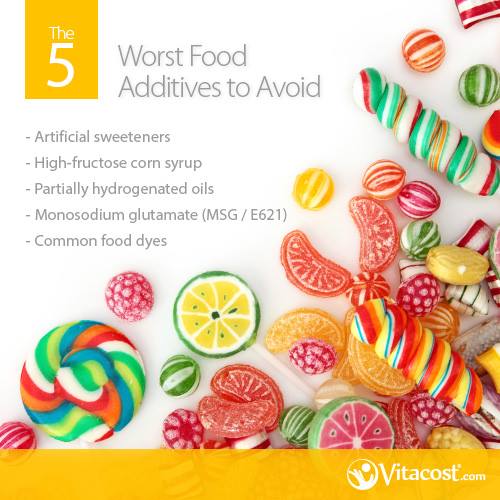It’s tedious to read the labels on almost everything you buy, but unless you really shop only the periphery of the supermarket, it’s a habit with a big payback. Don’t put any stock in the word “natural.” Just head straight for the facts by scanning the ingredients. Processed foods are a big red flag, and they can dominate the shopping cart. According to the magazine Healthy Living, the percent of the grocery budget spent on processed foods and sweets has doubled from 12% in 1982 to 23% in 2012. Any time you buy a package of processed food that’s not organic, you are risking exposing yourself and your family to a bevy of artificial food additives—many of which do your health no favors.

1. Artificial Sweeteners
Aspartame, also known as the brand names Nutrasweet and Equal (and before that Sweet’N Low), can be found whenever foods are labeled “diet” or “sugar free.” The Center for Science in the Public Interest warns that some artificial sweeteners can be dangerous in large quantities. Aspartame is a neurotoxin and believed to be carcinogenic.
Found in: Diet or sugar-free sodas, desserts, sugar free gum, drink mixes, baking goods, table top sweeteners, cereal, breath mints, pudding, ice tea, chewable vitamins and toothpaste.
2. High Fructose Corn Syrup
High fructose corn syrup (HFCS) is a highly refined artificial sweetener whose use has exploded since 1980. Large amounts promote tooth decay, increase triglyceride (fat) levels in blood, thereby increasing the risk of heart disease, and play havoc with the hormones that affect satiety. Basically, HFCS is a cheap form of sugar—and only slightly more harmful than ordinary sugar. But its presence is a tip-off that you are choosing a processed food that’s over sweetened. According to the Center for Science in the Public Interest, the Dietary Guidelines for Americans (America’s basic nutrition policy), American Heart Association and other health authorities recommend that people consume no more than about 3 to 8 percent of calories in the form of refined sugars. (The current average for Americans is 15 percent of calories come from refined sugars.) The bottom line: the fewer added sugars—fructose, sucrose or HFCS—one consumes the better.
Found in: Most processed foods, breads, candy, flavored yogurts, salad dressings, canned vegetables and cereals.
3. Monosodium Glutamate (MSG / E621)
As most of you know, MSG is an amino acid used as a flavor enhancer in soups, salad dressings, chips, frozen entrees and many restaurant foods. What many of you don’t know is that the use of MSG allows companies to reduce the amount of real ingredients in their foods, such as the chicken in chicken soup. It gives food manufacturers a cheap version of “authentic.” Basically MSG is an excitotoxin—a substance that overexcites cells to the point of damage. Studies show that regular consumption of MSG may result in flushing, heart palpitations, numbness, nausea, fatigue and headaches.
Found in: Chinese and Asian food, many snacks, chips, cookies, seasonings, most Campbell Soup products, frozen dinners, lunch meats and some Parmesan cheese.
4. Partially Hydrogenated Oils
Partially hydrogenated oils are how trans fats are listed on an ingredient label. Trans fat, used to enhance and extend the shelf life of food products, is one of the major culprits behind heart disease. According to the Center for Science in the Public Interest, the Institute of Medicine has advised consumers to consume as little trans fat as possible, ideally less than about 2 grams a day (that much might come from naturally occurring trans fat in beef and dairy products). Harvard School of Public Health researchers estimate that trans fat had been causing about 50,000 premature heart attack deaths annually, making partially hydrogenated oil one of the most harmful ingredients in the food supply. In Denmark the government has banned trans fatty acids exceeding 2 percent, a move that effectively eliminates foods containing partially hydrogenated oils.
Found in: Fat, oil, shortening, stick margarine, crackers, fried restaurant foods, baked goods, icing and microwave popcorn.
5. Common Food Dyes
Used mainly in junk foods, food dyes may contribute to behavioral problems such as hyperactivity in some sensitive children as well as induce allergic reactions. Food dyes are best avoided: They are simply synthetic chemicals used to make foods more fun and appealing, especially for children (think sprinkles). Watch out for these ones in particular:
Blue #1 and Blue #2 (E133)
Found in: Candy, cereal, soft drinks, sports drinks and pet foods.
Red dye #3 (also Red #40 – a more current dye) (E124)
Found in: Fruit cocktail, maraschino cherries, cherry pie mix, ice cream, candy, bakery products and more!
Yellow #5 and #6 (E110) and Yellow Tartrazine (E102)
Found in: American cheese, macaroni and cheese, chips and crackers, especially those that are cheese-flavored, candy and carbonated beverages, cereals and lemonade.
